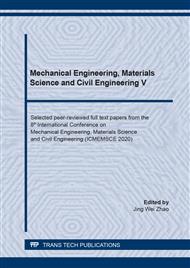[1]
K. Iqbal, A. Khan, M.M.A.K. Khattak, Biological significance of Ascorbic acid (Vitamin C) in human health -A review, Pakistan, J. Nutrition.3 (2004) 5-13.
Google Scholar
[2]
P.A. Krishna, K.J. Hae, Electrochemical detection of ascorbic acid with chemically functionalized carbon nanofiber/β-cyclodextrin composite, Chemical Physics Letters.757 (2020) 137881.
DOI: 10.1016/j.cplett.2020.137881
Google Scholar
[3]
H.Y. Han, Z.H. Sheng, J.G. Liang, Electrogenerated chemiluminescence from thiol-capped CdTe quantum dots and its sensing application in aqueous solution, Anal. Chim. Acta.596(2007) 73-78.
DOI: 10.1016/j.aca.2007.05.039
Google Scholar
[4]
S. Cavaliere-Jaricot, M. Darbandi, E. Kucur, T. Nann. Silica coated quantum dots: a new tool for electrochemical and optical glucose detection, Microchim Acta.160(2008)375-383.
DOI: 10.1007/s00604-007-0795-y
Google Scholar
[5]
Z. Yue, W. Khalid, M. Zanella, A.Z. Abbasi, A. Pfreundt, Evaluation of quantum dots applied as switchable layer in a light-controlled electrochemical sensor, Anal Bioanal Chem. 396 (2010) 1095 - 1103.
DOI: 10.1007/s00216-009-3347-y
Google Scholar
[6]
R. Gill, M. Zayats, I. Willner, Semiconductor Quantum Dots for Bioanalysis, Angew Chem Int Ed. 47(2008)7602-7625.
DOI: 10.1002/anie.200800169
Google Scholar
[7]
K. Schubert, W. Khalid, Z. Yue, W.J. Parak, F. Lisdat, Quantum-Dot-Modified Electrode in Combination with NADH-Dependent Dehydrogenase Reactions for Substrate Analysis, Langmuir. 26(2010)1395-1400.
DOI: 10.1021/la902499e
Google Scholar
[8]
D. Hafeman, J. Parce, H. McConnell, Light addressable potentiometric sensor for biochemical system, Science. 240(1988)1182-1185.
DOI: 10.1126/science.3375810
Google Scholar
[9]
C. Stoll, C. Gehring, K. Schubert, M. Zanella, W.J. Parak, F. Lisdat, Photoelectrochemical signal chain based on quantum dots on gold-Sensitive to superoxide radicals in solution, Biosens Bioelectron. 24(2008)260–265.
DOI: 10.1016/j.bios.2008.03.039
Google Scholar
[10]
Z. Yue, W. Zhang, C. Wang, G.H. Liu, W.C. Niu, CdS-FePt dimers based photoelectrochemical sensor for detection of H2O2, Materials Letters.74(2012)180-182.
DOI: 10.1016/j.matlet.2012.01.069
Google Scholar
[11]
L.P. Tu, X. Yu, G.W. Xu, Performance of Photoelectrochemical Sensors Based on Doped QDs under Various Bias Voltage, Materials Science Forum.1001(2020) 175-180.
DOI: 10.4028/www.scientific.net/msf.1001.175
Google Scholar


